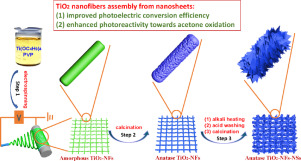当前位置:
X-MOL 学术
›
Chin. J. Catal.
›
论文详情
Our official English website, www.x-mol.net, welcomes your
feedback! (Note: you will need to create a separate account there.)
Fabrication of TiO2 nanofiber assembly from nanosheets (TiO2-NFs-NSs) by electrospinning-hydrothermal method for improved photoreactivity
Chinese Journal of Catalysis ( IF 15.7 ) Pub Date : 2020-01-01 , DOI: 10.1016/s1872-2067(19)63470-4 Yachao Lu , Xiaoyu Ou , Wenguang Wang , Jiajie Fan , Kangle Lv
Chinese Journal of Catalysis ( IF 15.7 ) Pub Date : 2020-01-01 , DOI: 10.1016/s1872-2067(19)63470-4 Yachao Lu , Xiaoyu Ou , Wenguang Wang , Jiajie Fan , Kangle Lv

|
Abstract Hierarchically structured nanomaterials have attracted much attention owing to their unique properties. In this study, TiO2 nanofibers assembled from nanosheets (TiO2-NFs-NSs) were fabricated through electrospinning technique, which was followed by hydrothermal treatment in NaOH solution. The effect of hydrothermal reaction time (0–3 h) on the structure and properties of TiO2 nanofibers (TiO2-NFs) was systematically studied, and TiO2-NFs was evaluated in terms of the photocatalytic activity toward photocatalytic oxidation of acetone and the photoelectric conversion efficiency of dye-sensitized solar cells. It was found that (1) hydrothermal treatment of TiO2-NFs in NaOH solution followed by acid washing and calcination results in the formation of TiO2-NFs-NSs; (2) upon extending the hydrothermal reaction time from 0 h to 3 h, the BET surface area of TiO2-NFs-NSs (T3.0 sample) increases 3.8 times (from 28 to 106 m2 g−1), while the pore volume increases 6.0 times (from 0.09 to 0.54 cm3 g−1); (3) when compared with those of pristine TiO2-NFs (T0 sample), the photoreactivity of the optimized TiO2-NFs-NSs toward acetone oxidation increases 3.1 times and the photoelectric conversion efficiency increases 2.3 times. The enhanced photoreactivity of TiO2-NFs-NSs is attributed to the enlarged BET surface area and increased pore volume, which facilitate the adsorption of substrate and penetration of gas, and the unique hollow structure of TiO2-NFs-NSs, which facilitates light harvesting through multiple optical reflections between the TiO2 nanosheets.
中文翻译:

通过静电纺丝-水热法从纳米片 (TiO2-NFs-NSs) 制备 TiO2 纳米纤维组件以提高光反应性
摘要 分层结构的纳米材料由于其独特的性质而备受关注。在这项研究中,由纳米片(TiO2-NFs-NSs)组装而成的 TiO2 纳米纤维通过静电纺丝技术制造,然后在 NaOH 溶液中进行水热处理。系统研究了水热反应时间 (0-3 h) 对 TiO2 纳米纤维 (TiO2-NFs) 结构和性能的影响,并根据对丙酮光催化氧化的光催化活性和光电转化率评估了 TiO2-NFs染料敏化太阳能电池的效率。发现(1)在NaOH溶液中对TiO2-NFs进行水热处理,然后酸洗和煅烧导致TiO2-NFs-NSs的形成;(2) 将水热反应时间从 0 h 延长至 3 h,TiO2-NFs-NSs(T3.0 样品)的 BET 表面积增加了 3.8 倍(从 28 到 106 m2 g-1),而孔体积增加了 6.0 倍(从 0.09 到 0.54 cm3 g-1);(3)与原始TiO2-NFs(T0样品)相比,优化后的TiO2-NFs-NSs对丙酮氧化的光反应性提高了3.1倍,光电转换效率提高了2.3倍。TiO2-NFs-NSs 增强的光反应性归因于 BET 表面积的扩大和孔体积的增加,这有助于基材的吸附和气体的渗透,以及 TiO2-NFs-NSs 独特的中空结构,这有助于通过TiO2 纳米片之间的多次光学反射。0 次(从 0.09 到 0.54 cm3 g−1);(3)与原始TiO2-NFs(T0样品)相比,优化后的TiO2-NFs-NSs对丙酮氧化的光反应性提高了3.1倍,光电转换效率提高了2.3倍。TiO2-NFs-NSs 增强的光反应性归因于 BET 表面积的扩大和孔体积的增加,这有助于基材的吸附和气体的渗透,以及 TiO2-NFs-NSs 独特的中空结构,这有助于通过TiO2 纳米片之间的多次光学反射。0 次(从 0.09 到 0.54 cm3 g−1);(3)与原始TiO2-NFs(T0样品)相比,优化后的TiO2-NFs-NSs对丙酮氧化的光反应性提高了3.1倍,光电转换效率提高了2.3倍。TiO2-NFs-NSs 增强的光反应性归因于 BET 表面积的扩大和孔体积的增加,这有助于基材的吸附和气体的渗透,以及 TiO2-NFs-NSs 独特的中空结构,这有助于通过TiO2 纳米片之间的多次光学反射。
更新日期:2020-01-01
中文翻译:

通过静电纺丝-水热法从纳米片 (TiO2-NFs-NSs) 制备 TiO2 纳米纤维组件以提高光反应性
摘要 分层结构的纳米材料由于其独特的性质而备受关注。在这项研究中,由纳米片(TiO2-NFs-NSs)组装而成的 TiO2 纳米纤维通过静电纺丝技术制造,然后在 NaOH 溶液中进行水热处理。系统研究了水热反应时间 (0-3 h) 对 TiO2 纳米纤维 (TiO2-NFs) 结构和性能的影响,并根据对丙酮光催化氧化的光催化活性和光电转化率评估了 TiO2-NFs染料敏化太阳能电池的效率。发现(1)在NaOH溶液中对TiO2-NFs进行水热处理,然后酸洗和煅烧导致TiO2-NFs-NSs的形成;(2) 将水热反应时间从 0 h 延长至 3 h,TiO2-NFs-NSs(T3.0 样品)的 BET 表面积增加了 3.8 倍(从 28 到 106 m2 g-1),而孔体积增加了 6.0 倍(从 0.09 到 0.54 cm3 g-1);(3)与原始TiO2-NFs(T0样品)相比,优化后的TiO2-NFs-NSs对丙酮氧化的光反应性提高了3.1倍,光电转换效率提高了2.3倍。TiO2-NFs-NSs 增强的光反应性归因于 BET 表面积的扩大和孔体积的增加,这有助于基材的吸附和气体的渗透,以及 TiO2-NFs-NSs 独特的中空结构,这有助于通过TiO2 纳米片之间的多次光学反射。0 次(从 0.09 到 0.54 cm3 g−1);(3)与原始TiO2-NFs(T0样品)相比,优化后的TiO2-NFs-NSs对丙酮氧化的光反应性提高了3.1倍,光电转换效率提高了2.3倍。TiO2-NFs-NSs 增强的光反应性归因于 BET 表面积的扩大和孔体积的增加,这有助于基材的吸附和气体的渗透,以及 TiO2-NFs-NSs 独特的中空结构,这有助于通过TiO2 纳米片之间的多次光学反射。0 次(从 0.09 到 0.54 cm3 g−1);(3)与原始TiO2-NFs(T0样品)相比,优化后的TiO2-NFs-NSs对丙酮氧化的光反应性提高了3.1倍,光电转换效率提高了2.3倍。TiO2-NFs-NSs 增强的光反应性归因于 BET 表面积的扩大和孔体积的增加,这有助于基材的吸附和气体的渗透,以及 TiO2-NFs-NSs 独特的中空结构,这有助于通过TiO2 纳米片之间的多次光学反射。











































 京公网安备 11010802027423号
京公网安备 11010802027423号